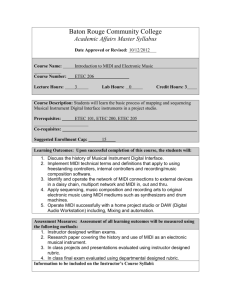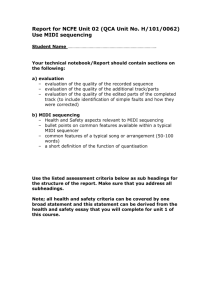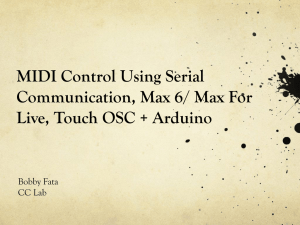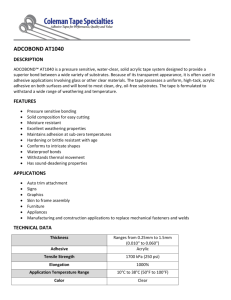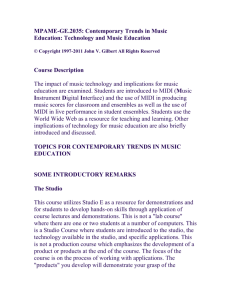more_tape_tips
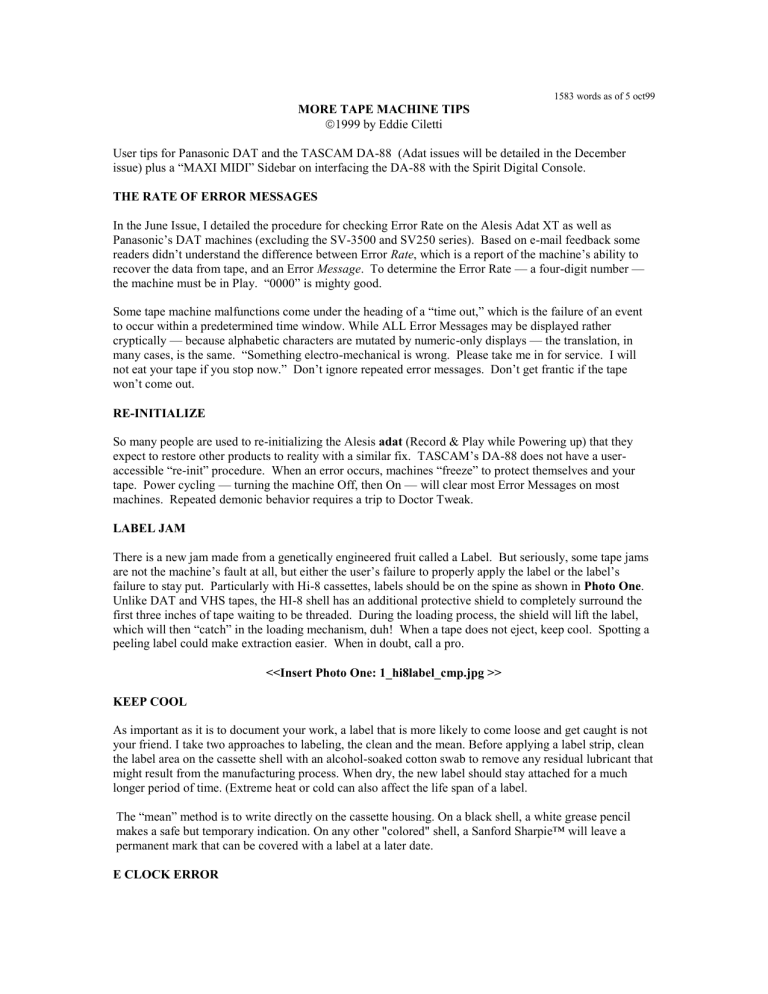
1583 words as of 5 oct99
MORE TAPE MACHINE TIPS
1999 by Eddie Ciletti
User tips for Panasonic DAT and the TASCAM DA-88 (Adat issues will be detailed in the December issue) plus a “MAXI MIDI” Sidebar on interfacing the DA-88 with the Spirit Digital Console.
THE RATE OF ERROR MESSAGES
In the June Issue, I detailed the procedure for checking Error Rate on the Alesis Adat XT as well as
Panasonic’s DAT machines (excluding the SV-3500 and SV250 series). Based on e-mail feedback some readers didn’t understand the difference between Error Rate , which is a report of the machine’s ability to recover the data from tape, and an Error Message . To determine the Error Rate — a four-digit number — the machine must be in Play. “0000” is mighty good.
Some tape machine malfunctions come under the heading of a “time out,” which is the failure of an event to occur within a predetermined time window. While ALL Error Messages may be displayed rather cryptically — because alphabetic characters are mutated by numeric-only displays — the translation, in many cases, is the same. “Something electro-mechanical is wrong. Please take me in for service. I will not eat your tape if you stop now.” Don’t ignore repeated error messages. Don’t get frantic if the tape won’t come out.
RE-INITIALIZE
So many people are used to re-initializing the Alesis adat (Record & Play while Powering up) that they expect to restore other products to reality with a similar fix. TASCAM’s DA-88 does not have a useraccessible “re-init” procedure. When an error occurs, machines “freeze” to protect themselves and your tape. Power cycling — turning the machine Off, then On — will clear most Error Messages on most machines. Repeated demonic behavior requires a trip to Doctor Tweak.
LABEL JAM
There is a new jam made from a genetically engineered fruit called a Label. But seriously, some tape jams are not the machine’s fault at all, but either the user’s failure to properly apply the label or the label’s failure to stay put. Particularly with Hi-8 cassettes, labels should be on the spine as shown in Photo One .
Unlike DAT and VHS tapes, the HI-8 shell has an additional protective shield to completely surround the first three inches of tape waiting to be threaded. During the loading process, the shield will lift the label, which will then “catch” in the loading mechanism, duh! When a tape does not eject, keep cool. Spotting a peeling label could make extraction easier. When in doubt, call a pro.
<<Insert Photo One: 1_hi8label_cmp.jpg >>
KEEP COOL
As important as it is to document your work, a label that is more likely to come loose and get caught is not your friend. I take two approaches to labeling, the clean and the mean. Before applying a label strip, clean the label area on the cassette shell with an alcohol-soaked cotton swab to remove any residual lubricant that might result from the manufacturing process. When dry, the new label should stay attached for a much longer period of time. (Extreme heat or cold can also affect the life span of a label.
The “mean” method is to write directly on the cassette housing. On a black shell, a white grease pencil
makes a safe but temporary indication. On any other "colored" shell, a Sanford Sharpie™ will leave a permanent mark that can be covered with a label at a later date.
E CLOCK ERROR
Nearly every device has a backup battery to store user and, for some tape machines, alignment parameters.
When the battery goes bad, Al S. Heimer moves in. The first clue that the battery is unhappy is the inability to store memory presets (the DA-88 has two). In addition, an “E-Clock” error usually refers to a missing external Word or Video reference, but a leaky battery can eat circuit board traces, damaging the system board and creating this message and a whole slew (sp?) of strange symptoms.
Whether or not a problem is noticed, you should immediately check the battery. To do so, remove the DA-
88’s cover. There are three large Philips screws on each side and a rear-accessed smaller screw at the top middle of the machine. Under the cover, there may be a copper plate that must also be removed. The battery is about the size of quarter on the left side of the SYSTEM board (when the machine’s face is positioned at your chest).
<< Insert Photo Two: 2_88_bat_fix.jpg>>
Photo Two shows a Panasonic BR2325 replacing the original Sanyo CR2430. I chose the Panasonic part because the yellow band covers the seam around the circumference where the “plus” and “minus” plates meet an insulating ring. This is where gases (and worse) escape. If this has happened, immediately clean any schmutz with a cotton swab soaked in acetone.
Suspect a machine claiming low head hours. Have the battery checked. These Lithium batteries should be
3 volts. (A leak doesn’t necessarily affect the voltage but it does increase battery noise.) Since there are many older DA-88s in the field, take advantage of any excuse to take yours in for technical evaluation.
Have the battery changed and the circuit board repaired (as shown, if needed) and ask the technician to make sure all the new mechanical updates are installed. (This includes a self-cleaning kit, new reel tables, slide cam and, in some versions, the “cam and sector gear.”)
DA-88 FAN MOD
The DA-88 has a fan to cool its LINEAR power supply while the DA-38 and DA-98 have a more efficient
SWITCHING supply that requires no additional cooling. The stock DA-88 fan pulls air through the unit, from the sides as well as the tape insertion slot, which draws dirt into the mechanism.
<<Insert Photo 3-a: 3a_88_filter_clean.jpg>>
<<Insert Photo 3-b: 3b_88_filter_clogged.jpg>>
While Tascam has not ever implemented my fan mod, I feel it is essential and, if you don't believe my words, then believe Photo 3-a (a new filter) and Photo 3-b (a dirty filter with 800 hours of “Play” time and untold hours of ON time ) ! Better outside than in, don’t cha think?
REEL (Tension) PROBLEMS
Contaminated reel table clutches can cause an array of problems for a DA-88. The reel tables have been redesigned three times and all have shorter life without the fan mod. A bad Supply Table Clutch will seriously reduce the life of the heads when Reverse Cue is used. A failing Take-Up Clutch will have erratic tension, putting a heavy strain on the capstan servo system and causing the machine to take longer to lock to itself, let alone another machine.
Dirt and bad clutches, combined with a typically high factory back-tension setting, can reduce head life to far short of the expected 1,000 hours. The FAN mod and the minimum tension setting — detailed at www.tangible-technology.com
— were previously detailed in this column. I believe attention to these simple details extends head life.
Please see the Sidebar, MAXI MIDI, for tips on using MIDI Machine Control with the DA-88.
PANASONIC FINALE
Last year I discovered a Panasonic DAT recorder problem while teaching a DAT repair class at CTG in
Atlanta GA. This year, after making a point to check and replace the parts in question I still had great difficulty with machines jamming. This was frustrating for my client and embarrasing for me, because the machines burned in over a weekend and tested fine. Thanks to Glenn at Coleman Audio, I rediscovered the back tension felt and lever, which must be replaced even if the performance seems normal.
Several defective parts can contribute to a tape-hungry machine. None are user-serviceable, but Photo
Four details the one failure mode you can undo, at least enough to retrieve the tape. When the Left Slant
Block attempts to return the tape to the shell, the Black Plastic Tension Arm does not move out of the way fast enough. (The “crash site” is outlined in red.) Position the loading drawer as shown and buy some bamboo skewers (they make safe tools for nudging delicate DAT parts). With the skewers, move the slant block, and then the tension arm, in the directions indicated by the arrows.
<<Insert Photo 4: 4_3700jam.jpg>>
I’m outta room! This article does not assume you “know it all,” so if you need more info, visit www.tangible-technology.com
for the most extensive digital tape machine, self-help info on line.
See ya next month for the adat stuff! (Be sure to check out the Sidebar: DA-88 MAXI MIDI for help with
MIDI sync issues.)
~~~~~~~~~~~~~~~~~~~~~~~~~~~~~~~~~~~~~~~~~~~~~~~~~~~~~~~~~
Eddie Ciletti repairs tape machines for a living. (Does it show?)
~~~~~~~~~~~~~~~~~~~~~~~~~~~~~~~~~~~~~~~~~~~~~~~~~~~~~~~~~
Sidebar: DA-88 MAXI MIDI
While on the subject of DA-88 communications, here’s a tip from TASCAM’s customer service department. When interfacing to the Spirit Digital Console — or similar MIDI remote control via MIDI
Machine Control (MMC) — check these user options:
On rear of the sy-88 card, check that dip switch 2 is in the UP position for MIDI Machine Control.
(The ALTERNATIVE setting is for Sony 9-pin / RS-422 control.) For this option set dip switch 2
DOWN, the “off” position.
NOTE:
With ALL dip-switch options, the DA-88 must be re-powered in order for the new settings to take effect.
SETTING the MIDI ID NUMBER and MIDI ID OFFSET
The default DA-88 MIDI device assignment is ID-1. Manufacturers differ in the way they implement the
MIDI device assignment range. TASCAM’s IDs range from 1 to 128 while other products may choose to shift the range by “one,” resulting in IDs that range from 0 to 127. If the latter is the case, you will need to
“offset” the value. TASCAM’s ID-1 would translate to another manufacturer’s ID-0.
SYNCHRONIZATION
The DA-88 can easily be the master, outputting both MIDI Timecode (MTC) or SMPTE Timecode. This assumes you have an SY-88 card or MMC-88 adapter (this adapter converts the proprietary machine information from DB-15 connector to MTC and MMC).
DA-88 as MASTER…
SETUP (with SY-88)
OPTION 1 : Stripe the dedicated TC track with the desired frame rate (30 NDF for MIDI, typical).
OPTION 2: Use the ABS to SMPTE option.
The FRAME RATE from the machine must match that of the receiving device.
Once recorded, the frame rate of the recorded TC track cannot be changed without first being rerecorded.
If converting ABS to SMPTE, the FRAME RATE can be reconfigured.
DA-88 as SLAVE?
The TASCAM DA-88 will only slave to SMPTE and not MTC, unless you have a MIDI to SMPTE converter box such as the MOTU Midi Timepiece (AV) or Digital Timepiece.
End of sidebar
